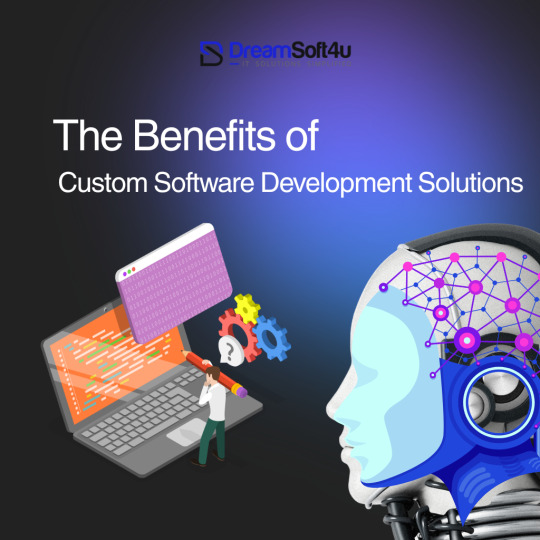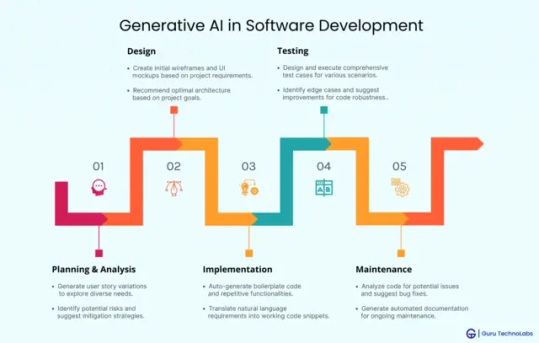#Software Development Life Cycle
Explore tagged Tumblr posts
Text
Mastering the Software Development Life Cycle: A Guide for Aspiring Professionals.
It all starts with understanding the Software Development Life Cycle (SDLC).
Our SDLC certification course is designed to help you gain a deep understanding of each stage in the development process—planning, designing, building, testing, and deploying software.
This certification not only boosts your knowledge but also proves to employers that you're serious about quality, efficiency, and success in software projects.

0 notes
Text

Flexibility, scalability, and improved security are just a few top-tier benefits of embracing custom software development solutions. In this post, we’ll explore how tailored software can streamline operations, boost productivity, and help your business gain a competitive edge. You’ll also see how a custom-built approach leads to more efficient and cost-effective results, especially when compared to off-the-shelf tools. Visit Original Source: The Benefits of Custom Software Development Solutions
#custom software development#software development life cycle#healthcare software solutions#web development services#mobile app development#custom web development#dreamsoft4u#software development company#mobile app development company
0 notes
Text
0 notes
Text
What is the role of GenAI in the Software Development Life Cycle(SDLC)?

The Software Development Life Cycle (SDLC) is a structured process used by software developers to design, develop, test, and deploy software applications. The SDLC typically comprises several stages: requirement analysis, system design, development, testing, deployment, and maintenance. Each phase plays a crucial role in ensuring the software meets the desired quality standards and user requirements.
Adding GenAI to the SDLC has many advantages like improved efficiency, precision, and speed. GenAI can automate routine tasks, create new solutions, and offer predictive insights, changing the way software is created, tested, and managed. This helps organizations release top-notch software quicker and more affordably.
Get better understanding with Generative AI vs Traditional AI to help you get knowledge on the software development lifecycle.
Evolution of AI in Software Development
Generative AI refers to AI systems designed to generate new content or solutions by learning from existing data. In software development, GenAI can create code, design software architectures, generate test cases, and even simulate user interactions. These capabilities make GenAI a powerful tool for automating and enhancing various stages of the SDLC.
AI has evolved significantly in software development, starting from simple rule-based systems to advanced machine learning models. Initially, AI was used for automating basic tasks and providing decision support. With the advent of machine learning and neural networks, AI has become more sophisticated, enabling developers to leverage GenAI for complex tasks such as code generation, automated testing, and predictive maintenance.
Stages of SDLC and the Role of GenAI
Requirement Analysis
Benefits of Using GenAI for Requirement Gathering
GenAI can analyze vast amounts of data to identify user needs and requirements accurately. By processing user feedback, market trends, and historical data, GenAI can generate comprehensive requirement documents, reducing the time and effort required for manual analysis.
Example Use Cases
For instance, a GenAI system can analyze customer reviews and support tickets to identify common pain points and feature requests. This information can then be used to prioritize requirements and ensure the final product meets user expectations.
System Design
GenAI in Designing Software Architecture
Generative AI in Software Development can assist in designing software architecture by generating design patterns and suggesting optimal system structures. It can analyze existing architectures, identify potential improvements, and provide recommendations for designing scalable and efficient systems..
Tools and Techniques
Various tools, such as deep learning frameworks and design pattern generators, leverage GenAI to automate the system design process. These tools can create architectural diagrams, generate code templates, and suggest best practices for software design.
Development
How GenAI Automates Coding and Development Tasks
GenAI can automate coding tasks by generating code snippets, completing functions, and even creating entire modules based on high-level specifications. This accelerates the development process and ensures consistency and accuracy in the codebase.
Case Studies of GenAI in Action
Several companies have successfully implemented GenAI in their development workflows. For example, OpenAI's Codex can generate code in various programming languages based on natural language inputs, significantly reducing the time developers spend on writing boilerplate code.
Testing
Enhancing Software Testing with GenAI
Generative AI in SDLC enhances software testing by generating test cases, predicting potential bugs, and automating test execution. It can analyze code changes and suggest relevant test scenarios, ensuring comprehensive test coverage.
Automated Testing Tools Powered by GenAI
Tools like Testim and Applitools use GenAI to automate visual testing, regression testing, and end-to-end testing. These tools can identify UI discrepancies, detect functional issues, and ensure the software meets quality standards.
Deployment
Streamlining Deployment Processes with GenAI
Generative AI in Software Development streamlines deployment processes by automating configuration management, continuous integration, and continuous delivery. It can predict deployment risks, optimize resource allocation, and ensure seamless software releases.
Real-World Applications
Companies like Netflix use GenAI to manage their deployment pipelines. GenAI systems monitor deployment processes, identify potential issues, and automatically roll back changes if necessary, ensuring high availability and reliability.
Maintenance
GenAI in Software Maintenance and Updates
Generative AI in SDLC plays a crucial role in software maintenance by predicting issues before they occur, automating bug fixes, and suggesting updates. It can analyze system logs, user feedback, and performance metrics to identify areas for improvement.
Predictive Maintenance with AI
Predictive maintenance powered by GenAI helps organizations anticipate hardware failures, optimize system performance, and reduce downtime. By analyzing historical data and usage patterns, GenAI can provide actionable insights for proactive maintenance.
Benefits of Implementing GenAI in SDLC
Improved Efficiency and Productivity
GenAI automates repetitive tasks, allowing developers to focus on high-value activities. This leads to increased productivity and faster development cycles.
Enhanced Accuracy and Reduced Errors
By leveraging GenAI's predictive capabilities, developers can minimize errors and ensure higher accuracy in code and design. GenAI can detect potential issues early, reducing the risk of defects in the final product.
Cost Reduction
Automating various stages of the SDLC with GenAI reduces the need for manual intervention, leading to significant cost savings. Organizations can allocate resources more effectively and reduce development and maintenance costs.
Accelerated Time-to-Market
GenAI accelerates the software development process by automating tasks, generating code, and providing predictive insights. This enables organizations to bring products to market faster and respond to changing market demands more effectively.
Challenges and Considerations
Technical Challenges
Integrating Generative AI in SDLC requires technical expertise and a robust infrastructure. Organizations must address challenges related to data quality, model training, and system integration to fully leverage Generative AI's capabilities.
Ethical and Legal Considerations
The use of GenAI raises ethical and legal concerns, such as data privacy, algorithmic bias, and intellectual property rights. Organizations must establish clear guidelines and ensure compliance with relevant regulations to mitigate these risks.
Ensuring Security and Privacy
GenAI systems must be designed with security and privacy in mind. Protecting sensitive data, ensuring secure model training, and preventing unauthorized access are critical considerations for deploying GenAI in the SDLC.
Conclusion
Generative AI plays a transformative role in the Software Development Life Cycle, offering numerous benefits such as improved efficiency, accuracy, and cost reduction. By automating tasks, generating innovative solutions, and providing predictive insights, Generative AI enhances every stage of the SDLC, from requirement analysis to maintenance.
However, organizations must address technical, ethical, and security challenges to fully realize the potential of Generative AI in software development. As the technology continues to evolve, the integration of Generative AI in SDLC is set to become a standard practice, driving innovation and improving software quality across industries.
0 notes
Text
#agile development#backend development#conclusion#continuous deployment#continuous integration#deployment#designing#DevOps#DevOps engineer#documentation#FAQs#frontend development#introduction#lean development#maintenance#product manager#Programming Languages#quality assurance engineer#requirement analysis#scrum master#software development#software development jobs#software development life cycle#software engineer#test-driven development#testing#types of software development#user documentation#what is software development
0 notes
Text
Embedding security throughout the software development life cycle (SDLC) is vital for protecting digital assets. From planning to maintenance, integrating security measures like code reviews and threat modeling mitigates risks and builds trust. By fostering a security-aware culture among teams, organizations ensure proactive risk management and resilient software systems.
#security in software development#software development#protecting in digital asset#software development life cycle
0 notes
Text
1 note
·
View note
Text
0 notes
Text
#avientech#What do software developer do?#Which course is best for software developer?#How do I start software development?#Where can I study software development?#software development courses#software development examples#software development meaning#software development company#software development life cycle#software development languages#Software development jobs#software development process
0 notes
Text
Best Approaches for Develop Software Applications for Start-ups – Cuneiform
As a start-up, you are a new bug in this competitive industry, and you want to have and give the finest enhancement and experience for the your business as well as your committed clients. In terms of software, today every small and large-scale business has acquired some for software for official use. as a use of software development life cycle.

Methodology for New Businesses: Ideation: We (Cuneiform Consulting) look at the objectives of your business and your target market to determine the most lucrative market niche and a unique selling proposition that will set your product apart from the competition.
Product design: Taking into account the requirements of both your business and your target market, we build a product with the optimal combination of features, architecture, UX/UI, integration strategy, and technology stack.
Planning the project: At this stage of the development project plan, the project's goals, deliverables, team members, and key to these performance indicators are all introduced, along with a thorough work breakdown structure, a communication plan, and a risk mitigation strategy.
We configure the app's infrastructure, backup and recovery process Infrastructure security, and distribution of the solution to end users in step six, the product launch.
Software development methods:
It is customary to use a development methodology, a predetermined approach of project management, when developing new software for a business. The two most well-liked strategies for producing new software are agile and waterfall.
Agile: A project management approach that allows you to work on many phases of the software development life cycle (SDLC) at once.
Each SDLC phase must be completed before going on to the next in the approach known as "waterfall."
The five essential components software development life cycle: Organizing and establishing a product vision Calculating, creating, and prototyping Short-Sprint Software Development Showing the product in action Adaptive iterations
Cuneiform Consulting is a product development company that specializes in assisting start-ups with software development and offering the best software development solutions available.
#Software Development Life Cycle#Product development#Project management#Software application development
0 notes
Text
Your business needs to run all operations in a smooth manner with effective software maintenance and support services. It is crucial for you to understand that investing in software maintenance provides you with a competitive advantage as compared to those competitors who are not investing in maintenance functions.
0 notes
Text

Top 5 Software Development Methodologies:-
Understanding the top 5 software development methodologies is crucial for optimising the software development life cycle. Agile, Waterfall, Scrum, DevOps, and Lean each offer distinct approaches to managing projects. From iterative Agile feedback to Waterfall's structured phases, these methodologies help teams improve efficiency, adapt to changes, and ensure successful project delivery within the development life cycle.
1 note
·
View note
Text
#software development life cycle#product design#product development#electronic#electronics#technology
0 notes
Text
#software development#software development life cycle#agile software development#windows software development kit#agile software development life cycle#software development methodologies#software development process#software development engineer#software development jobs#lean software development#software development company#software development apprenticeship#software development agreement#software development associate degree#software development agile#software development analyst#software development amortization#software development architecture#software development agencies#software development activities#software development approaches#agile software development is based on#amazon software development engineer salary#adaptive software development#ab software development#amazon software development manager salary#amazon software development engineer#agile software development in software engineering#software development bootcamp#software development best practices
1 note
·
View note
Text
0 notes